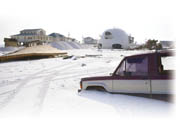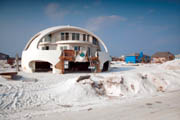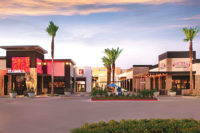
In 1995, the Sigler's home was destroyed by Hurricanes Opal and Erin, respectively. To prepare themselves for further emergencies, they enlisted Jonathan Zimmerman, a Bay area-architect that designs steel-reinforced concrete shells. This specialized construction, although contrasting with conventional structures, is built to withstand very extreme and violent weather conditions. Completed in the summer of 2003, it was celebrated on a local and national level, and garnered much press for its unorthodox construction and built-to-last structure.
Some 18 months after its completion, the Dome Home was put to test by Florida's most destructive slew of hurricanes in 2004. Sigler and Zimmerman reported how well their labor of love fared for Ivan the Terrible.
"I came down about three or four days ahead (of the hurricane)," says Sigler.
Because the Dome Home is property that the Siglers rent out seasonally, there were guests there that had to be evacuated a few days before the hurricane hit. MSNBC had several reporters in the area, four of which stayed at the Dome Home.
"They brought four SUVs full of supplies and we loaded up the house with generators," Sigler says. "Two of the vehicles left the island, went back to the satellite truck on the mainland and checked into their hotel.
"During the storm, the roof blew off their hotel and all the windows blew out and they had to flee the hotel and they took their car back to the satellite truck-all the windows had been blown out. They couldn't transmit out anything," he says. "We stayed in the house and slept through the storm."
To sleep through a hurricane suggests that the building performed as it was engineered: to withstand hardcore winds. The steel reinforced concrete structure of an aerodynamic shape can take up to 300 miles per hour blasts. Because of the home's shell shape, winds just bounce off the structure. Another way to ensure that the home was secure without pieces of it being torn off was the purchase of high wind load windows. Sigler chose Anderson Impact Windows, which are designed to resist flying objects at up to 125 miles per hour.

Apocalypse now?
"The winds started cranking from the northeast," Sigler remarks. "By 8:00 p.m., it was starting to crank pretty hard. Waves were breaking over the road, under the house-it was obvious we weren't going anywhere. The roads had been closed for quite a while. So, by 9:00, 10:00 p.m., it was blowing hard from that direction. Then about midnight, as it came closer to shore, the wind switched around and came from the southeast, going northwest and waves were crashing hard against the house. About 12:30 a.m., it was probably up to its highest intensity."At this time, we had done all we could do," he continues. "The wind was howling outside, people were calling us on our cell phones but we could talk in a normal voice. You could hear it when we turned the power generator off; you could hear single drops of water like they were coming in the exhaust. You could hear the storm outside raging but the house was quiet.
"We had a little leakage around the doors and one of the bathrooms," Sigler says. "It was ripping away the staircases and ripping away the concrete underneath the house. Inside, while it was happening, we could hear some banging but there was no shaking. We were amazed at the level of destruction the next morning when the sun came up."
Fortunately, the home suffered no major damage (compared to neighboring homes, whose properties were for the most part destroyed). Inevitably, the home was struck by several pieces of neighboring homes whose elements were torn off.
"The ground floor of the home was churned into rubble by the roiling effect of the 10-foot storm surge," Zimmerman explains. "The swimming pool, landscaping, foundations and trees were erased.
"The outer coating of the balloon is a Rhino liner type spray coating used on the shell, the vertical walls and to seal around door and window trim," he continues.
September 16 is the date Ivan hit the Panhandle area. President Bush declared the area a national disaster and ordered all federal disaster aid resources to be distributed, FEMA reported in a press release after the hurricanes. The hurricane rated a Category 3 in the Saffir-Simpson scale (of strength), which rates hurricanes from one to five according to wind speeds and destructive force. The third category has winds from 111 to 130 miles an hour and has a storm surge of 9 to 12 feet, and classified "damage extensive." FEMA reported several fatalities from Ivan.
Given the live reports from the Dome Home, where its solid structure safely kept the MSNBC media guests and Sigler, with only very minimal damage to the property, has there been more interest in this wave of architecture?
"Right now the agencies are dealing with the Blue Roof Syndrome," Zimmerman says. "They have to deal with the thousands of damaged roofs draped in blue plastic and getting the owners squared away with immediate and rehabilitative services before they can deal with what can protect them next time."



Report Abusive Comment